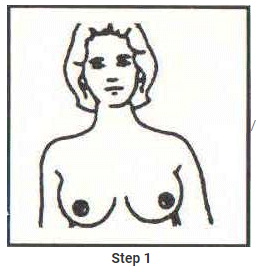What is Breast Cancer?
Breast Cancer is a disease in which cells in the breast grow and multiply abnormally. This can happen if the genes in a cell that control cell growth no longer work properly. As a result, the cell divides uncontrollably and may form a tumor. You may be able to feel it as a lump under the skin, or you may not realize it's there at all until it's found on an imaging test, such as a mammogram (breast x-ray).
Causes of Breast Cancer
- Family history of cancer
- Genetic factors
- Menstrual history
Symptoms Breast Cancer
- A lump or thickness in or near the breast or under the arm
- Unexplained swelling or shrinkage of the breast, particularly on one side only
- Dimpling or puckering of the breast
- Nipple discharge (fluid) other than breast milk that occurs without squeezing the nipple
- Breast skin changes, such as redness, flaking, thickening, or pitting that looks like the skin of an orange
- A nipple that becomes sunken (inverted), red, thick, or scaly
Preventions Breast Cancer
- Maintain ideal body weight
- Exercise regularly
- Quit smoking and excessive alcohol consumption
- Breast-feed the baby
- Avoid unnecessary radiation exposure
Breast Self-Examination (BSE)

Stand in front of the mirror with your shoulders straight and arms on hips and look at your breasts Are they their usual size, shape, and colour?
Is this any visible distortion or swelling?
Consult doctor if there is:
- Dimpling, puckering, or bulging of the skin
- Changed position or an inverted nipple (pushed inward instead of sticking out)
- Redness, rash, or swelling of the breasts

Now, raise your arms and look for the same changes.
Look for any dimpling of skin or in-drawing nipple.

While you’re at the mirror, gently squeeze each nipple between your finger and thumb
Consult doctor if nipple discharge is milky or yellow fluid or blood.

- Lie down and use your right hand to feel your left breast and then your left hand to feel your right breast.
- Use a firm, smooth touch with the pad of your 3 middle fingers, keeping the fingers flat and together.
- Cover your entire breast from top to bottom, side to side; from your collar bone to the top of your abdomen and from your armpit to your cleavage.
- Begin at the nipple, moving in larger and larger circles until you reach the outer edge of the breast. Also move your fingers up and down vertically, in rows.
- Begin examining each area with a very soft touch, and then increase pressure feel the deeper tissue.

- Feel your breasts while you are standing or sitting.
- It is easier to feel your breasts when their skin is wet and slippery (like while taking bath).
- Cover your entire breast, using the same hand movements described in Step 4.
Do Monthly Breast Self Examination!
Do Monthly Breast Self Examination!
Diagnosis of Breast Cancer
1. Clinical Breast Examination
2. Imaging Tests
- Mammogram
- Breast ultrasound
- MRI scan
3. Biopsy
- Fine needle aspiration biopsy/cytology (FNAB/FNAC)
- Core needle breast biopsy
- Surgical (open) biopsy
- Nipple discharge cytology (nipple discharge exam)
Treatment of Breast Cancer
- Surgery
- Radiation therapy
- Chemotherapy
- Hormone therapy
- Targeted therapy
Salient Features of Breast Cancer
- 24 x 7 full-time dedicated specialists
- Experienced team of doctors which includes, Breast Cancer expert, breast reconstruction expert, radiologist, medical oncologists, pathologist
- Personalised Breast Cancer screening and monitoring plans for women
